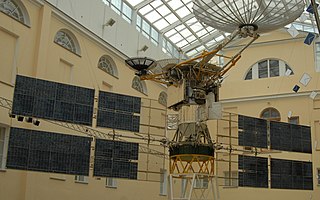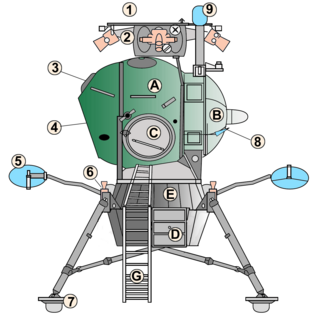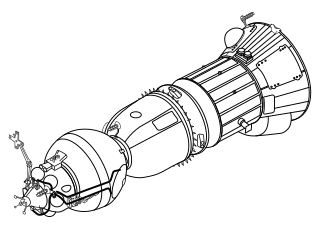Kosmos 27, also known as Zond 3MV-1 No.3 was a space mission intended as a Venus impact probe. The spacecraft was launched by a Molniya 8K78 carrier rocket from Baikonur. The Blok L stage and probe reached Earth orbit successfully, but the attitude control system failed to operate.

Soyuz is a series of spacecraft which has been in service since the 1960s, having made more than 140 flights. It was designed for the Soviet space program by the Korolev Design Bureau. The Soyuz succeeded the Voskhod spacecraft and was originally built as part of the Soviet crewed lunar programs. It is launched on a Soyuz rocket from the Baikonur Cosmodrome in Kazakhstan. Between the 2011 retirement of the Space Shuttle and the 2020 demo flight of SpaceX Crew Dragon, the Soyuz served as the only means to ferry crew to or from the International Space Station, for which it remains heavily used. Although China did launch crewed Shenzhou flights during this time, none of them docked with the ISS.
Zond was the name given to two distinct series of Soviet robotic spacecraft launched between 1964 and 1970. The first series, based on the 3MV planetary probe, was intended to gather information about nearby planets.

Zond 7, a formal member of the Soviet Zond program and unmanned version of Soyuz 7K-L1 manned Moon-flyby spacecraft, the first truly successful test of L1, was launched towards the Moon on a Proton-K D rocket on August 7, 1969, on a mission of further studies of the Moon and circumlunar space, to obtain color photography of Earth and the Moon from varying distances, and to flight test the spacecraft systems. Earth photos were obtained on August 9, 1969. On August 11, 1969, the spacecraft flew past the Moon at a distance of 1984.6 km and conducted two picture taking sessions. On its way back from the moon the spacecraft tested its radio systems by transmitting recorded voices. Zond 7 reentered Earth's atmosphere on August 14, 1969, and achieved a soft landing in a preset region south of Kustanai, Kazakhstan. On its trip the craft carried 4 turtles. A human-like tissue-equivalent phantom for radiation measurements has been placed aboard. The phantom was equipped with 20 channels for radiation detectors distributed along the whole body for measurement of doses in critical organs. The doses accumulated during the flight through the radiation belts and around the Moon were between 0.2 and 0.7 rad in different points at the depth of 3 g/cm2 from the body surface.
Kosmos 60 was an E-6 No.9 probe, launched by the Soviet Union. It was the sixth attempt at a lunar soft-landing mission, with a design similar to that of Luna 4.
Kosmos is a designation given to many satellites operated by the Soviet Union and subsequently Russia. Kosmos 1, the first spacecraft to be given a Kosmos designation, was launched on 16 March 1962.

The Luch Satellite Data Relay Network (SDRN), also referred to as Altair and Gelios, is a series of geosynchronous Russian relay satellites, used to transmit live TV images, communications and another telemetry from the Soviet/Russian space station Mir, the Russian Orbital Segment (ROS) of the International Space Station and other orbital spacecraft to the Earth, in a manner similar to that of the US Tracking and Data Relay Satellite System.
Kosmos 140, Soyuz 7K-OK No.3, was an uncrewed flight of the Soyuz spacecraft. It was the third attempted test flight of the Soyuz 7K-OK model, after orbital and launch failures of the first two Soyuz spacecraft.

The LK was a lunar module developed in the 1960s as a part of several Soviet crewed lunar programs. Its role was analogous to the American Apollo Lunar Module (LM). Three LK modules, of the T2K variant, were flown without crew in Earth orbit, but no LK ever reached the Moon. The development of the N1 launch vehicle required for the lunar flight suffered setbacks, and the first Moon landings were achieved by US astronauts. As a result, both the N1 and the LK programs were cancelled without any further development.

Soyuz 7K-OK was the first generation of Soyuz spacecraft and was flown between 1967 and 1971. The 7K-OK was used for the first ferry flights to the Salyut space station program, beginning a long history of space station service that continues today with the International Space Station (ISS).

The Soyuz 7K-LOK, or simply LOK was a Soviet crewed spacecraft designed to launch men from Earth to orbit the Moon, developed in parallel to the 7K-L1. The LOK would carry two cosmonauts, acting as a mother ship for the LK Lander which would land one crew member to the surface. It was part of the N1-L3 programme which also included the LK lander and the N1 rocket.

The Soyuz 7K-L1 "Zond" spacecraft was designed to launch men from the Earth to circle the Moon without going into lunar orbit in the context of the Soviet crewed Moon-flyby program in the Moon race. It was based on the Soyuz 7K-OK. Several modifications reduced vehicle mass and increased circumlunar capability. The most notable modifications were the replacement of the orbital module with a support cone and a high-gain parabolic antenna, the removal of a reserve parachute, and the addition of the gyro platform and star navigation sensors for the far space navigation. The spacecraft was capable of carrying two cosmonauts. At the start of flight testing, there were serious reliability problems with the new Proton rocket, the 7K-L1, and the Soyuz 7K-OK that the L1 was based on.

The Soviet Union planned several military Soyuz spacecraft models. These versions were named Soyuz P, Soyuz PPK, Soyuz R, Soyuz 7K-VI, and Soyuz OIS . However, none ever flew in space.

The 1975 Apollo–Soyuz Test Project version of the Soyuz spacecraft served as a technological bridge to the third generation Soyuz-T spacecraft (1976–1986).

GLONASS-M, also known as Uragan-M are the second generation of Uragan satellite design used as part of the Russian GLONASS radio-based satellite navigation system. Developed by ISS Reshetnev, it had its debut launch in 2003, and is in the process of being phased out. Its production is expected to finish in 2015 and as of July, 2015, its last launch was expected in late 2017. It is an evolution of the previous Uragan second-generation satellites, improving accuracy, increasing power, extending the design life and adding the FDMA L2OF open signal. The last eight Glonass-M spacecraft in production include the new CDMA L3OC open signal.

Globus IMP instruments were spacecraft navigation instruments used in Soviet and Russian crewed spacecraft. The IMP acronym stems from the Russian expression Indicator of position in flight, but the instrument is informally referred to as the Globus. It displays the nadir of the spacecraft on a rotating terrestrial globe. It functions as an onboard, autonomous indicator of the spacecraft's location relative to Earth coordinates. An electro-mechanical device in the tradition of complex post-World War II clocks such as master clocks, the Globus IMP instrument incorporates hundreds of mechanical components common to horology. This instrument is a mechanical computer for navigation akin to the Norden bombsight. It mechanically computes complex functions and displays its output through mechanical displacements of the globe and other indicator components. It also modulates electric signals from other instruments.
Kosmos 146, also known as L-1 No. 2P, was a Soviet test spacecraft precursor to the Zond series, launched from the Baikonur Cosmodrome aboard a Proton K rocket.
Kosmos 154, also known as L-1 No.3P, was a Soviet test spacecraft launched from the Baikonur aboard a Proton-K rocket. It was a prototype Soyuz 7K-L1 launched by Proton. It was an uncrewed precursor to the Zond series.
Zond L1S-1 was a Zond capsule to be placed into orbit around the Moon by the first launch of the N1, a Soviet made super heavy-lift launch vehicle designed to land manned Soviet spacecraft on the Moon. The Zond capsule was equipped with a dummy lander and cameras to photograph the lunar surface for possible sites of a manned landing. The failure of the N1 launch vehicle caused the launch escape system to ignite, saving the Zond capsule from destruction.
Zond program was a Soviet robotic spacecraft program launched between 1964 and 1970, using two spacecraft series, one for interplanetary exploration, and the other for lunar exploration.














